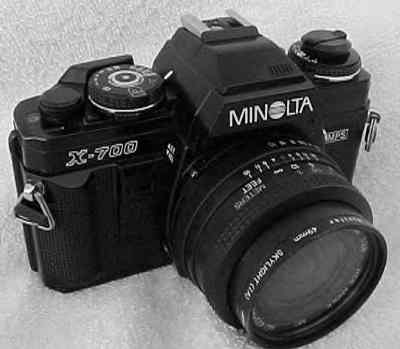

X-700
(1981) By 1981, the top-of-the-line camera from Minolta, the XD-11, was four years old. Their XG cameras were selling well, but their XD cameras were in a slump. Afterall, with the introduction of the XG-M, the XD cameras had little to offer the consumer that was not avaliable in the highly-evolved XG line. To top it off, the XG cameras even had some new features that the XD cameras lacked. Sure, the XD cameras offered shutter-priority automatic exposure, but it was not particularly convenient for the photographer to use. First, you had to decide on and select a shutter speed. Then you had to set the lens to f16, and then you had to remember to set the exposure-mode lever to "S". Pretty involved for an "automatic" mode. The demand for the shutter-preferred exposure mode was less than anticipated, since consumers found the aperture-preferred mode much easier to use. In this mode, you simply and quickly set the exposure dial to "A" and the exposure would probably be OK. That's it, although you might sometimes need to adjust the aperture a little. Afterall, simplicity is the whole purpose of an automatic-exposure mode. If it's not simple and quick, you might as well match needles!
Minolta decided that what was needed was a camera with an even easier exposure mode, and the X-700 was born. It has the same body styling as the XG-M, but the big difference is that this is the first Minolta SLR to offer programmed-exposure automation. It also offers aperture-preferred exposure control, metered manual, and manual modes. Thankfully, the shutter-preferred mode was finally laid to rest and gone for good. Actually, there was a couple of minor differences between the body of the XG-M and the X-700. The X-700 added a new audible signal -- a beep -- when the self-timer was used and when the shutter speed was slow. There are little vents on the top of the pentaprism of the X-700 -- where the beeper is. The ON/OFF switch controls the beeper.
But the X-700 brought other changes as well. For example, the X-700 offers off-the-film (OTF) flash exposure mode. This is a big improvement over a regular flash, and even regular automatic flash, since the light from the flash unit is read through-the-lens (TTL) and is controlled by the meter in the camera. It compensates automatically for any filters or extensions that are on the camera (unlike the earlier X-series flashes that just set the correct shutter speed on the camera automatically and then read the light a few inches above the lens). This feature is GREAT for close-up work, and makes complicated calculations or adjustments a thing of the past. There are two drawbacks, however. If your film is physically lighter or darker than "normal", the exposures will be off. Plus, you need special TTL flash units to operate in OTF flash mode, so Minolta came out with a new line of flash units, called "PX" flashes, such as the 132PX ($105, list), 280PX ($114 list), 360PX ($176, list), and Macro 80PX ($299, list). With the X-700, regular flashes and X-series flashes operate just like they always did, but they will not provide OTF flash.
The viewfinder of the X-700 was similar to that of the XG-M camera. The recommended (i.e., metered) shutter speed appear on the right of the screen on the familiar LED scale, and the manually-set aperture appears on the bottom. The exposure mode now appears at the top of the LED scale (instead of the bottom), and shows an "M" for manual mode, an "A" for aperture-priority mode, or a "P" for programmed-exposure mode.
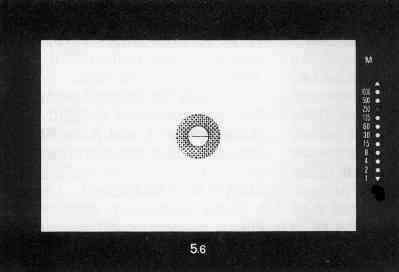
One improvement over the XD-11 was that the exposure mode selector lever was now incorporated into the shutter speed dial. There was no longer any confusion about what mode you are in. In programmed mode, the shutter speed dial is set to "P". In aperture-preferred mode, it is set to an "A". In manual mode, the individual speed is selected. All on the same dial! It took four years, but Minolta finally got it right. In addition, the viewfinder of the X-700 displays a "P", "A", or an "M" to remind you of what mode you are in. You still have to set the lens aperture to the minimum in programmed-exposure mode, just like you did to use the XD-11 in shutter-preferred mode, but in the X-700, the "P" in the viewfinder will blink if you forget. The X-700, like the XG-M, still fails to show you the set shutter speed when in manual mode (unlike the older XE-7 and XK cameras, and the later X-570 and X-9), so I guess Minolta didn't get it completely right. Oh well, it was a step in the right direction anyway.
The programmed exposure mode of the X-700 was designed to be used with
MD lenses, but Minolta decided to "update" their MD Rokkor-X
line of lenses, and created the Minolta MD line.
This is the current and final series of manual-focus lenses from Minolta.
Since Minolta had nearly perfected lens features by this time, the
differences from the earlier MD Rokkor-X series were
minimal, and largely cosmetic. Most noticeably, they dropped the ROKKOR
name from the lens nameplate. These lenses are simply marked "Minolta"
-- both in the US market and abroad.
In addition, a lock was added on the MD pin feature. Many people found
that the aperture ring could be moved off of the smallest aperture setting
(which was used for the shutter-priority and programmed exposure modes) too
easily on the MD Rokkor-X lenses, leading to exposure
and viewfinder-display limitations. This lock prevented this problem.
It required an additional change, however. Since the focal length
of the lens had been inscribed on the lens barrel exactly in the same place
where the MD lug lock needed to be, Minolta moved the focal length marking
to the other side (left side) of the f-stop scale. The major changes
on these lenses were (not all lenses had these):
The basic features are the same between the X-700 and the XG-M, with the exception of the programmed exposure mode, OTF flash, AE lock, and a slight difference in the exposure compensation dial. In the XG-M, the dial is limited at the top and the bottom of the film speed scale. For example, at ISO 1600, the exposure compensation dial cannot be set for under-exposure. On the X-700, the film speed range is increased (ISO 12-3200) and the exposure compensation dial can use any setting -- even at the extreme ISO speeds. The X-700 retained the "touch-switch" of the XG series and can use the XG Auto Winder. It can also use the new MD-1 Motor Drive of the XG-M as well as the XG-series data backs. But new optional accessories were added with the X-700 (some of which operated with some of Minolta's later -- and older -- cameras). A new Multi-Function back was introduced ($284, list) with date and intervalometer functions, and new interchangeable focusing screens became available. In addition, a new Wireless Controller to go along with the backs and motor drives was unveiled ($167, list) with remote operation up to 200 feet. The shutter speed on the X-700, in automatic mode, was increased from the 1-1,000 of the XG and XD series to 4-1/000. This matched the range of the earlier XE cameras, but was still below the range of the older XK series (16 seconds to 1/2,000). Similarly, the X-700 used the horizontal, cloth shutter of the XG series and abandoned the vertical, metal shutter of the XD and XE series -- leaving the X-700 with a slightly slower synch speed than some would like (1/60).
There were actually three versions of the X-700, but the model is not inscribed on the camera.
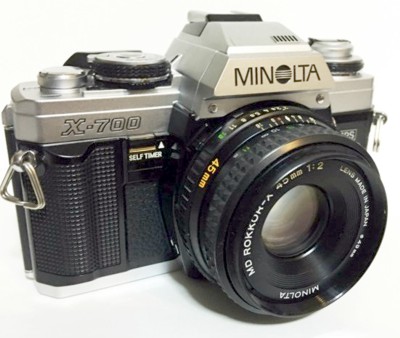
The original model of the X-700 is very hard to find. You can identify this version with the words "SELF TIMER" under the "X-700". That's right, the self-timer switch was moved from near the rewind crank, since it has the same body as the XG-M.
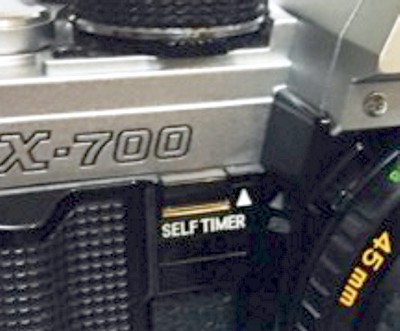
The X-700 (model a) is most often seen in chrome, but some were
made in black.

For some strange reason, Minolta wasn't happy with simply moving the self-timer to the front of the camera and almost immediately after releasing the X-700 (model a), they produced the X-700 (model b). Actually, the self-timer is still on the front, and the switch looks the same, but the words "SELF TIMER" are removed and the letters "S.T." are now imprinted on the side of the prism instead.
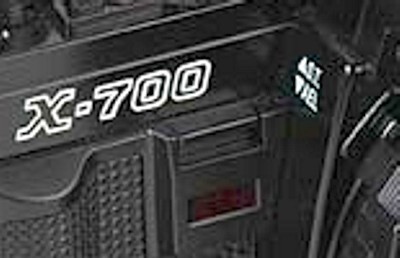
Go figure. Maybe too many people were referring to the original X-700 as the X-700 SELF TIMER. Who knows? But Minolta wasn't happy for some reason! And Minolta didn't stop there. They decided to add an exposure lock to the X-700 -- even though the camera already had a +/- 2EV exposure compensation dial and full manual control for those few people who prefer to override the automatic exposure. Minolta added this new feature to the self-timer switch. Pull it up for the self-timer; push it down for the exposure lock. The prism is marked "AEL" (for "Auto-Exposure Lock"), right under the "S.T." so you won't forget it's there, and little arrows remind you in which way to push the button. The X-700 (model b) is only available in black and is the only Minolta SLR to offer an exposure compensation dial and an AE lock button on the same camera.
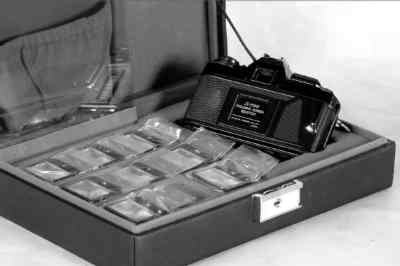
There is actually a third model of the X-700, but it was a non-functioning
model designed for promotional purposes in camera shops. Very few were made.
The main difference was that the camera came with a complete set of
interchangeable viewing screens in a special case. The body of the camera
was modified slightly to allow quick changes of the screens -- not through
the lens opening -- but through a special slot in the BACK of the camera!
This necessitated disabling the shutter and metering systems.
In use, the TTL function can provide fill-in flash with TTL flash units. When the flash powers up, it automatically sets the shutter speed to 1/60. Neither the shutter speed nor the f-stop is modified by adjusting the exposure compensation, film speed or AE lock, but the flash is. The flash output is decreased by increasing the film speed, setting the exposure compensation dial to a minus setting, or using the AE lock while pointing the camera at a brighter object. When the flash is turned on, the shutter speed is fixed at 1/60 and the flash fires at a reduced level, providing fill-in flash. Some would say this is an improvement over non-TTL flash, but users of non-TTL auto flash can achieve the same result with a simple changes -- depending on their flash unit -- such as changing to the next higher auto-mode without changing the f-stop.
Sometime around 1990, the production of the X-700 camera was moved to China. These cameras can be identified by the "China" stamped on the bottom of the camera. Some contend that the Chinese X-700 cameras are of inferior quality, but others maintain that this is hogwash. One important quality control issue pertains to the two capacitors in the X-700 (and the X-570 and X-300 cameras, as well). They tend to leak, and in the process, malfunction. You can usually spot a bad capacitor easily. Turn the camera on, using good batteries. Touching the shutter release button will turn on the LED meter for a second, but then it goes out. Some contend that the problem stems from the move to China and cheaper capacitors. There may be some truth to this as the earliest X-700 cameras have fewer capacitor problems. Models with serial numbers above 2700000 are those most likely to suffer from capacitor problems. Others contend that the capacitors leak with time, use and humidity. In any case, it's an expensive repair and one reason some people avoid the last models that Minolta made.
The X-700 is a conundrum -- a very contradictory camera. At the time, it was the top-of-the-line offering from Minolta, and very expensive ($440 list with a 50mm f1.7). Yet its programmed exposure mode was really designed for amateurs -- those who did not want to make any exposure decisions for themselves. And the camera was packed with ways to override the expensive, programmed exposure feature! The X-700 sold well, but this was due to its advanced features, such as the OTF flash mode, more than to its programmed exposure mode. It's programmed-exposure mode definitely made it the ultimate “point n’ shoot” camera, but most people who want a “point n’ shoot” camera want to spend a lot less than what the X-700 cost. At the same time, the XG-A with a 45mm f2 sold for half that of the X-700. In fact, this "high-end" approach that most SLR camera companies were using helped drive a resurgence of the "rangefinder" camera. At the same time that Minolta was trying to sell the X-700, "rangefinder" cameras were showing up with programmed exposure, auto-focusing, zoom lenses, motorized film advance, and even TTL flash -- with smaller and lighter bodies, and at substantially reduced prices. What Minolta really needed was to offer the programmed exposure mode in a less expensive, simpler SLR, like the XG-A, targeting the amateur market. That never happened. In fact, the X-700 was Minolta's last manual-focus SLR to offer programmed exposure mode.
At least Minolta realized that the X-700 was too expensive and too feature-rich for most photographers. So at the same time as the X-700, they produced the X-570 and X-370 cameras. But both of these alternatives lacked the programmed exposure mode. Many of those that like the OTF mode of the X-700, opt instead for the X-570, which offers the OTF feature, without the programmed exposure mode -- at a reduced price. For a comparative look at the major features of the X-700 models, check out MINMAN's SLR table -- the world's most complete!

User's Reviews
OW rates the X-700 as "GREAT"
"I purchased my X-700 on ebay only after taking the time be become comfortable with the history of the seller and confident that the camera had a recent CLA. I enjoy using a manual focus camera and the quality of the pictures is excellent."
"As a new enthusiast, I enjoy the manual focus and the access to very reasonably priced top quality Rokkor lens. I would not consider most other Minolta models as my main shooter unless they have TTL flash capability. If I had chosen Nikon or Canon, I would not have been able to buy the number and quality of lens for the same price. Nor could I have bought an equivalent body. Very happy with this model."
"There are times when I would prefer a more compact and lighter camera. Most of my lens are heavy metal and the X-700 body is not light. There are times when auto focus would be prefered."
RAY rates the X-700 as "GREAT"
"I bought my first X-700 in 1985, grey market, from a mail order house in New Jersey. Before this, I was using a Konica and Chinon rangefinder cameras. I never had a problem with this camera. about 12 years and a burglary later, I had to replace the whole kit, which I did through carefully searching quality sellers on eBay. I have a used X-700 that I've been using since then and I'm about to replace the light seals, and never had a problem."
"The feel of the camera in your hand is right with the grips, the audible signals can be useful. The LEDs in the finder are clear and easy to understand. I like the way that the exposure lock and self-timer work. I like the fact that you can find inexpensive lenses used, and some 3rd party lenses new still for this body. I wanted one of the finest manual focus bodies out there with the most flexibility with plenty of accessories available at a moderate cost. That's what I like the most about this camera."
"The only drawbacks are no manual speeds, like the "O" speed on the XD series, in case of a battery failure. The weakness that exists with the shutter release magnet capacitors--but this has never been a problem for me on this camera."
RETURN TO THE MANUAL MINOLTA HOME PAGE
We didin't want to do this, but since other websites have been stealing our
stuff, we have no alternative but to state:
COPYRIGHT@1995-2023 by Joe McGloin.
All Rights Reserved. The material on this website is protected by US Federal
copyright laws. It cannot be copied or used in any manner without specific
approval from the owner.
The material on this website is protected by US Federal copyright laws. It cannot be copied or used in any manner without specific approval from the owner.